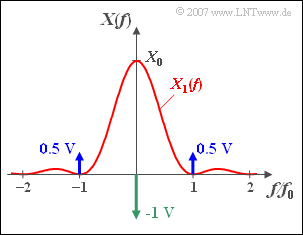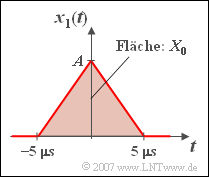Difference between revisions of "Aufgaben:Exercise 3.2Z: Sinc-Squared Spectrum with Diracs"
From LNTwww
m (Guenter moved page Exercise 3.2Z: Sinc-Squared-Spectrum with Diracs to Exercise 3.2Z: Sinc-Squared Spectrum with Diracs) |
|||
| (30 intermediate revisions by 5 users not shown) | |||
| Line 1: | Line 1: | ||
| − | {{quiz-Header|Buchseite= | + | {{quiz-Header|Buchseite=Signal_Representation/Fourier_Transform_and_Its_Inverse |
}} | }} | ||
| − | [[File:P_ID496__Sig_Z_3_2_neu.png|right| | + | [[File:P_ID496__Sig_Z_3_2_neu.png|right|frame|$\rm sinc^2$– spectrum with Diracs]] |
| − | + | The sketched spectrum ${X(f)}$ of a time signal ${x(t)}$ is composed of | |
| − | + | * a continuous component $X_1(f)$, | |
| − | + | * plus three discrete spectral lines ⇒ "Dirac functions". | |
| − | |||
| − | |||
| − | |||
| − | + | The continuous component with $f_0 = 200\, \text{kHz}$ and $X_0 = 10^{–5} \text{ V/Hz}$ is as follows: | |
| − | :$$ | + | :$$X_1( f ) = X_0 \cdot {\mathop{\rm sinc}\nolimits} ^2 ( {{f}/{f_0}} ),\quad {\rm where is}\quad {\mathop{\rm sinc}\nolimits} (x) = {\sin (\pi x)}/(\pi x).$$ |
| − | + | *The spectral line at $f = 0$ has the weight $–\hspace{-0.08cm}1\,\text{V}$. | |
| + | *In addition, there are two lines at frequencies $\pm f_0$, both with weight $0.5\,\text{V}$. | ||
| − | |||
| − | === | + | |
| + | |||
| + | |||
| + | |||
| + | ''Hints:'' | ||
| + | *This exercise belongs to the chapter [[Signal_Representation/Fourier_Transform_and_Its_Inverse|Fourier Transform and its Inverse]]. | ||
| + | *Further information on this topic can be found in the (German language) learning video [[Kontinuierliche_und_diskrete_Spektren_(Lernvideo)|Kontinuierliche und diskrete Spektren]] ⇒ "Continuous and discrete spectra". | ||
| + | |||
| + | *It can be assumed as known: A triangular pulse $y(t)$ with amplitude ${A}$, the absolute duration $2T$ and symmetrical about $t = 0$ $($i.e.: the signal values are $\ne 0 $ only between $–T$ and $+T$ ) has the following spectral function: | ||
| + | :$$Y( f ) = A \cdot T \cdot {\rm sinc}^2 ( f T ).$$ | ||
| + | |||
| + | |||
| + | ===Question=== | ||
<quiz display=simple> | <quiz display=simple> | ||
| − | { | + | {What are the values of the parameters ${A}$ (maximum) and ${T}$ (one-sided duration) of the triangular signal component $x_1(t)$? |
|type="{}"} | |type="{}"} | ||
| − | $A$ | + | $A\ = \ $ { 2 3% } $\text{V}$ |
| − | $T$ | + | $T\ = \ $ { 5 3% } $\text{$µ$s}$ |
| − | { | + | {What is the DC component ${B}$ of the signal? |
|type="{}"} | |type="{}"} | ||
| − | $B | + | $B\ = \ $ { -1.03--0.97 } $\text{V}$ |
| − | { | + | {What is the amplitude $C$ of the periodic component of $x(t)$? |
|type="{}"} | |type="{}"} | ||
| − | $C$ | + | $C\ = \ $ { 1 3% } $\text{V}$ |
| − | { | + | {What are the maximum and minimum values of the signal $x(t)$? |
|type="{}"} | |type="{}"} | ||
| − | $x_\text{max}$ | + | $x_\text{max}\ = \ $ { 2 3% } $\text{V}$ |
| − | $x_\text{min} | + | $x_\text{min}\hspace{0.2cm} = \ $ { -2.06--1.94 } $\text{V}$ |
| Line 49: | Line 58: | ||
</quiz> | </quiz> | ||
| − | === | + | ===Solution=== |
{{ML-Kopf}} | {{ML-Kopf}} | ||
| − | [[File:P_ID498__Sig_Z_3_2_a_neu.png|right|]] | + | [[File:P_ID498__Sig_Z_3_2_a_neu.png|right|frame|Area of the triangular pulse]] |
| − | '''1 | + | '''(1)''' The one-sided duration of the symmetrical triangular pulse is $T = 1/f_0\hspace{0.15 cm}\underline{ = 5 \,{\rm µ s}}$. |
| + | |||
| + | *The spectral value $X_0 = X_1(f = 0)$ indicates the pulse area of $x_1(t)$. | ||
| + | *This is equal to ${A} \cdot {T}$. From this follows: | ||
:$$A = \frac{X_0 }{T} = \frac{ 10^{-5}\rm V/Hz }{5 \cdot 10^{-6}{\rm s}}\hspace{0.15 cm}\underline{= 2\;{\rm V}}.$$ | :$$A = \frac{X_0 }{T} = \frac{ 10^{-5}\rm V/Hz }{5 \cdot 10^{-6}{\rm s}}\hspace{0.15 cm}\underline{= 2\;{\rm V}}.$$ | ||
| − | |||
| − | '''3 | + | '''(2)''' The DC component is given by the Dirac weight at $f = 0$. One obtains ${B} \hspace{0.15 cm}\underline{= -1 \,\text{V}}$. |
| + | |||
| + | |||
| + | '''(3)''' The two spectral lines at $\pm f_0$ together give a cosine signal with amplitude ${C} \hspace{0.15 cm}\underline{= 1 \text{V}}$. | ||
| + | |||
| + | |||
| + | '''(4)''' The maximum value occurs at time ${t} = 0$ (here the triangular pulse and cosine signal are maximum): | ||
| + | :$$x_{\text{max}} = A + B + C \hspace{0.15 cm}\underline{= +2 \text{V}}.$$ | ||
| − | + | *The minimum values of ${x(t)}$ result when the triangular pulse has decayed and the cosine function delivers the value $–\hspace{-0.08 cm}1 \,\text{V}$ : | |
| + | :$$x_\text{min} = {B} - {C}\hspace{0.15 cm}\underline{ = -2\, \text{V}}.$$ | ||
{{ML-Fuß}} | {{ML-Fuß}} | ||
__NOEDITSECTION__ | __NOEDITSECTION__ | ||
| − | [[Category: | + | [[Category:Signal Representation: Exercises|^3.1 Fourier Transform and Its Inverse^]] |
Latest revision as of 14:11, 24 May 2021
The sketched spectrum ${X(f)}$ of a time signal ${x(t)}$ is composed of
- a continuous component $X_1(f)$,
- plus three discrete spectral lines ⇒ "Dirac functions".
The continuous component with $f_0 = 200\, \text{kHz}$ and $X_0 = 10^{–5} \text{ V/Hz}$ is as follows:
- $$X_1( f ) = X_0 \cdot {\mathop{\rm sinc}\nolimits} ^2 ( {{f}/{f_0}} ),\quad {\rm where is}\quad {\mathop{\rm sinc}\nolimits} (x) = {\sin (\pi x)}/(\pi x).$$
- The spectral line at $f = 0$ has the weight $–\hspace{-0.08cm}1\,\text{V}$.
- In addition, there are two lines at frequencies $\pm f_0$, both with weight $0.5\,\text{V}$.
Hints:
- This exercise belongs to the chapter Fourier Transform and its Inverse.
- Further information on this topic can be found in the (German language) learning video Kontinuierliche und diskrete Spektren ⇒ "Continuous and discrete spectra".
- It can be assumed as known: A triangular pulse $y(t)$ with amplitude ${A}$, the absolute duration $2T$ and symmetrical about $t = 0$ $($i.e.: the signal values are $\ne 0 $ only between $–T$ and $+T$ ) has the following spectral function:
- $$Y( f ) = A \cdot T \cdot {\rm sinc}^2 ( f T ).$$
Question
Solution
(1) The one-sided duration of the symmetrical triangular pulse is $T = 1/f_0\hspace{0.15 cm}\underline{ = 5 \,{\rm µ s}}$.
- The spectral value $X_0 = X_1(f = 0)$ indicates the pulse area of $x_1(t)$.
- This is equal to ${A} \cdot {T}$. From this follows:
- $$A = \frac{X_0 }{T} = \frac{ 10^{-5}\rm V/Hz }{5 \cdot 10^{-6}{\rm s}}\hspace{0.15 cm}\underline{= 2\;{\rm V}}.$$
(2) The DC component is given by the Dirac weight at $f = 0$. One obtains ${B} \hspace{0.15 cm}\underline{= -1 \,\text{V}}$.
(3) The two spectral lines at $\pm f_0$ together give a cosine signal with amplitude ${C} \hspace{0.15 cm}\underline{= 1 \text{V}}$.
(4) The maximum value occurs at time ${t} = 0$ (here the triangular pulse and cosine signal are maximum):
- $$x_{\text{max}} = A + B + C \hspace{0.15 cm}\underline{= +2 \text{V}}.$$
- The minimum values of ${x(t)}$ result when the triangular pulse has decayed and the cosine function delivers the value $–\hspace{-0.08 cm}1 \,\text{V}$ :
- $$x_\text{min} = {B} - {C}\hspace{0.15 cm}\underline{ = -2\, \text{V}}.$$

